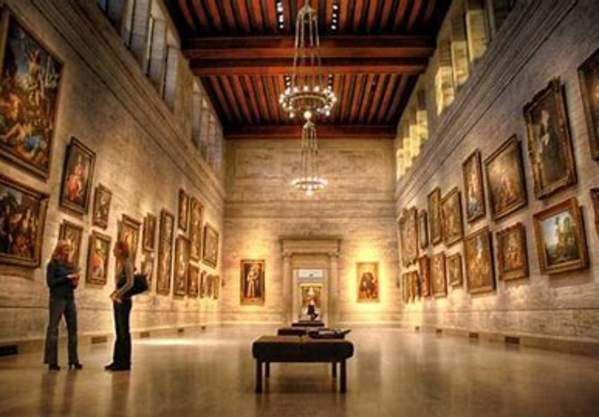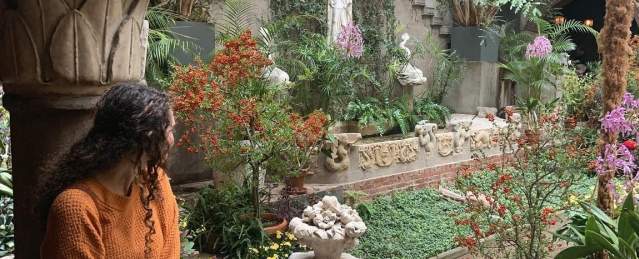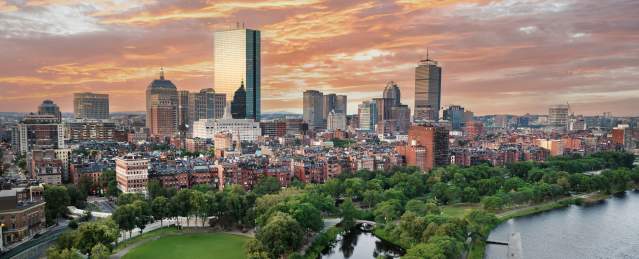The Innovation Trail
Discover Why Boston Might Just be the World's Most Innovative City
When people think of Boston, they often think of the city's rich history. But what about its history of innovation? From inventing the telephone and modern surgery to the Polaroid, microwave, and marshmallow fluff, Boston is a pretty innovative city! Over 21 stops, The Innovation Trail tells Boston's story after independence when societal changes like the abolition of slavery, women’s suffrage, waves of immigration, and marriage equality created a thriving innovation ecosystem that has helped shape the modern world.
Innovation Trail Sites | Map of the Innovation Trail
- Patent Pioneer
- Technicolor Movies
- The Ice King
- Combating an Epidemic
- Inventing the Telephone
- Surgery Without Pain
- Museum of Medical History and Innovation
- Boston Museum of Science
- Startup Hub
- Entrepreneur’s Walk of Fame
- MIT Museum
- Googling Cambridge
- MIT’s Cutting Edge
- Broad Discovery Center
- Human Genome Project
- Biotech Trailblazer
- Internet Accelerator
- Getting to the Moon
- Vaccine Breakthroughs
- Instant Photos
- The Last Candy Factory
Patent Pioneer
Back to Top of List30 School St., Boston
If you have an idea for something new, one of the ways to protect it from copycats — and eventually make money from it — is by filing a patent. In the 1860s, this building was the office of a patent law firm that employed Lewis Latimer, the son of parents who escaped from slavery in Virginia and fled to Massachusetts. Latimer helped the inventor of the telephone, Alexander Graham Bell, create the drawings used for the telephone’s first patent filing, and later, he worked with other inventors, including Hiram Maxim and Thomas Edison, to extend the useful life of the light bulb and make it easier to manufacture, filing several patents of his own.
Technicolor Movies
Back to Top of List88 Tremont Street, Boston
The three men who founded a company called Technicolor in 1914 were intrigued by early movies — which were in black and white. They thought they could develop a new movie camera and projection system that could show movies in more realistic colors. The first Technicolor film, “The Gulf Between” was shown for the first time here in 1917. While you would have been among the first people to see a color movie if you were here in 1917, it wasn’t until 1939 — the year that “Gone with the Wind” and “The Wizard of Oz” were made — that Technicolor convinced the movie industry that color was here to stay.
The Ice King
Back to Top of ListKing’s Chapel Burying Ground
One of the first millionaires in America was a man named Frederick Tudor, who was born in Boston. The business that made him rich? Shipping ice from frozen ponds in Massachusetts around the world, in the days before you could just plug in a freezer and start making your own cubes.
Combating an Epidemic
Back to Top of ListOutside the Government Center T Stop
One of the most important people in Boston’s early scientific history was an enslaved man named Onesimus, who was “given” to the preacher Cotton Mather by Mather’s congregation and lived in Mather’s house in the North End. Onesimus was born in the late 1600s and lived in Mather’s household in the early 1700s. One of the most feared diseases of the time was smallpox. Onesimus explained to Mather that in Africa, he had been inoculated against smallpox. His arm was cut open, and a small amount of material from a person infected with smallpox was inserted into the wound. Though Mather tried to promote the idea of inoculation as a smallpox epidemic gripped Boston in 1721, people at the time were skeptical of a medical procedure that seemed to be based on African customs. But Mather and a doctor who lived near present-day Government Center, Zabdiel Boylston, gathered data about the survival rates of those Bostonians who were inoculated. In the 1721 smallpox outbreak, only two percent of inoculated people died, compared to almost 15 percent of those who had not been inoculated. This was one of the earliest clinical trials on record in the US, using experimental and control groups to illustrate the effectiveness of inoculation.
Inventing the Telephone
Back to Top of ListOutside the JFK Federal Building, Cambridge Street, Boston
After the telegraph had been developed in the 1830s and begun to be used as the first real-time, long-distance communications technology, inventors began thinking about how to improve it. Maybe you could send multiple signals down the same wire, or perhaps even a human voice? The telegraph shop run by Charles Williams, Jr. was a magnet for telegraph tinkerers — including a Boston University professor named Alexander Graham Bell who invented something pretty successful here: the telephone. Williams liked the invention and had the first two telephones installed in his shop and his home in Somerville three miles away (which is still standing, at 1 Arlington Street, Somerville.) His phone numbers? 1 and 2
Surgery Without Pain
Back to Top of List55 Fruit St., Boston
In 1845, the head surgeon at Mass General, John Collins Warren, performed a tooth extraction on a medical student using the gas nitrous oxide to knock out the patient. Unfortunately, the dose wasn’t right, and the patient experienced just as much pain as if the gas hadn’t been used. Warren tried again in 1846, using a different gas, sulfuric ether, and a different person administering it, the Boston dentist William T.G. Morton. This time, after a patient had a tumor from his neck removed, he described the feeling as having his neck scratched a bit. The use of inhaled ether as an anesthetic spread around the world; it allowed surgeons to perform operations inside the body cavity without causing pain.
Museum of Medical History and Innovation
Back to Top of List2 North Grove St., Boston
Showcasing the evolution of medicine, including some of the instruments used in the first surgery with anesthesia, the Paul Russell Museum of Medical History and Innovation opened on the Mass General Hospital campus in 2012 and is free to the public.
Boston Museum of Science
Back to Top of List*Optional Detour
Visit the Museum of Science, founded in 1830 as the Boston Society of Natural History and was one of the first museums to bring all of the sciences together in one place.
Startup Hub
Back to Top of ListOne Broadway and 101 Main St., Cambridge
CIC may be home to more startups and venture capital firms than any other building on the planet. The CIC served as the first Massachusetts address for tech giants like Google, Apple, and Amazon. It was the original address for successful companies like HubSpot, a marketing software company that is now publicly traded and has an office of its own. CIC now operates similar shared office spaces in cities like Miami, Philadelphia, Rotterdam, Warsaw, and Tokyo.
Entrepreneur’s Walk of Fame
Back to Top of ListOutside the Kendall Square Marriott, Cambridge
Created in 2011, the Entrepreneur Walk of Fame recognizes founders and inventors like Thomas Edison, Steve Jobs of Apple, and Mitch Kapor of Lotus Development Corp.
MIT Museum
Back to Top of List314 Main Street, Cambridge
The new location of the MIT Museum opened in fall 2022 and showcases ongoing research and ingenuity at the world-famous Institute, while also displaying past achievements through its vast collection — including archives from Polaroid Corp., the pioneering maker of instant cameras, founded a few blocks away. The museum offers a range of exhibitions and installations, a state-of-the-art maker space where visitors can tinker and discover, and ongoing programs.
Googling Cambridge
Back to Top of List355 Main Street, Google Cambridge
Way back in the days before the iPhone — 2005 — Google bought a startup whose two co-founders were based in Cambridge and Silicon Valley. That startup was called Android, and it was working on a new operating system software for mobile phones. Its Cambridge-based co-founder, Rich Miner, began to hire engineers to work alongside him after the acquisition. So, Boston not only brought the world the telephone in the 19th century, but it also helped to create the world’s most popular smartphone operating system of the 21st century, with more than 2.5 billion Android users. As of 2021, Google’s Cambridge employees were working on projects for YouTube, Google Travel, and Google News.
MIT’s Cutting Edge
Back to Top of List32 Vassar St., Cambridge
Inside the Stata Center at MIT are labs focused on computer science, artificial intelligence, and robotics (they gave birth to iRobot Corp., maker of the Roomba robotic vacuum cleaner), and a small, fascinating ground-floor exhibit about student “hacks,” or pranks, through the years. The creator of the World Wide Web, Tim Berners-Lee, works here — though the web was invented when Berners-Lee worked in Switzerland.
Broad Discovery Center
Back to Top of List415 Main Street, Cambridge
The new Broad Discovery Center, a new museum from The Broad Institute of MIT and Harvard, tells the story of our emerging understanding of human health and disease.
Human Genome Project
Back to Top of List455 Main St, Cambridge
The Whitehead Institute was created to assemble a supergroup of the world’s top biomedical researchers in one building, eliminating “virtually any impediment to their pursuit of scientific discovery,” supplying ample funding and the most sophisticated lab equipment, but limited bureaucracy. When the Human Genome Project was seeking to map the entire human genome — described as the world’s largest collaborative biological project — the Whitehead was the single largest contributor. Groups at the Whitehead are currently seeking to understand the biology of infectious diseases; why cancer cells behave differently from healthy cells, and what enables them to multiply so quickly; new ways to model and understand how the brain works; and many other biological domains.
Biotech Trailblazer
Back to Top of List115 Broadway, Cambridge
Biogen is one of the earliest biotech companies. The company’s mastery of recombinant DNA technology — using enzymes to “cut and paste” sequences of DNA to achieve therapeutic effects — enabled it to develop a vaccine for hepatitis B, as well as the drug Avonex, which is used to treat multiple sclerosis. A Biogen drug approved in 2021, Aduhelm, targets Alzheimer’s disease.
Internet Accelerator
Back to Top of List145 Broadway, Cambridge
The headquarters of Akamai, a company that began life at MIT. Its original idea was to set up a network of servers around the world to cache, or store, content closer to where people wanted to access it — making everything show up faster on web browsers. Akamai today operates more than 300,000 servers around the world and generates $3.5 billion in annual revenue.
Getting to the Moon
Back to Top of List555 Technology Square
Draper Labs began life as a lab inside MIT and was eventually expanded to be an independent research and development lab. Among its greatest achievements are the guidance computers that enabled the Apollo spacecraft to successfully travel to and land on the moon. One of the software developers who wrote the code that ran these guidance computers was Margaret Hamilton, who later founded two companies and is credited as one of the people who defined the field of “software engineering.”
Vaccine Breakthroughs
Back to Top of List200 Technology Square
The headquarters of Moderna Pharmaceuticals, which was founded in 2010 to explore the potential of modified RNA molecules (hence the name “mod-RNA”) to treat diseases or serve as a vaccine. In 2020, Moderna developed and received emergency use authorization for a COVID-19 vaccine based on its modified RNA technology. Moderna’s vaccine was among the fastest vaccines ever developed.
Instant Photos
Back to Top of List700 Main Street, Cambridge
It’s hard to find a building with more ties to different eras of innovation than this one. When first constructed, it was the Davenport Car Works, one of the country’s first manufacturers of passenger railroad cars. Later, it was home to the Walworth Manufacturing Company, where a Walworth employee invented an adjustable wrench with incredible gripping power called the Stillson that is still in use today. This building was also the site of the first “long-distance” demonstration of Alexander Graham Bell’s telephone, from a Walworth office in Boston to this building, with Thomas Watson manning the equipment on this end. In the late 1930s, Edwin Land invented the first instant camera and started a company called Polaroid to market it. Even though Polaroid’s headquarters moved elsewhere in Cambridge, Land kept his private research lab in this building. Today, LabCentral is a shared laboratory space used by dozens of fledgling biotech companies.
The Last Candy Factory
Back to Top of List810 Main Street, Cambridge
At one point there were 66 different candy companies in Cambridge, making everything from candy hearts for Valentine’s Day to Squirrel Nut Zippers to lemon drops. This building is the last operating candy factory in Cambridge, owned by Tootsie Brands. The company unfortunately doesn’t offer tours, but inside they make 26 million pieces of candy a day.
View All Trails & Tours
Retrace the steps of Boston's first Gay Pride March, uncover the stories of a thriving colonial-era black community, walk in the footsteps of Irish immigrants, or discover Boston's innovative spirit. Check out Boston's top walking tours.
Museums & Attractions
Home to world-renowned museums, storied sports stadiums, star-studded concert venues, and distinguished performance theaters, you'll find what you're looking for in Boston.








